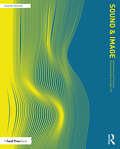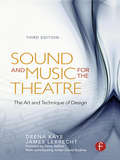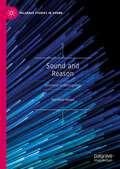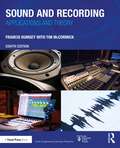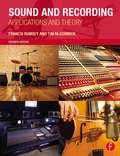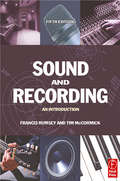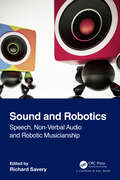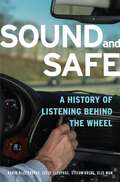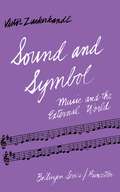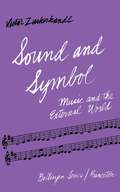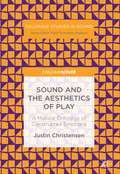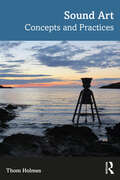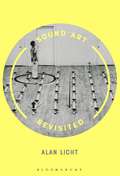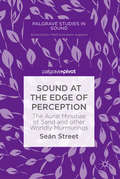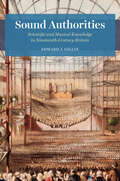- Table View
- List View
Sound and Image: Aesthetics and Practices (Sound Design)
by Andrew Knight-HillSound and Image: Aesthetics and Practices brings together international artist scholars to explore diverse sound and image practices, applying critical perspectives to interrogate and evaluate both the aesthetics and practices that underpin the audiovisual. Contributions draw upon established discourses in electroacoustic music, media art history, film studies, critical theory and dance; framing and critiquing these arguments within the context of diverse audiovisual practices. The volume’s interdisciplinary perspective contributes to the rich and evolving dialogue surrounding the audiovisual, demonstrating the value and significance of practice-informed theory, and theory derived from practice. The ideas and approaches explored within this book will find application in a wide range of contexts across the whole scope of audiovisuality, from visual music and experimental film, to narrative film and documentary, to live performance, sound design and into sonic art and electroacoustic music. This book is ideal for artists, composers and researchers investigating theoretical positions and compositional practices which bring together sound and image.
Sound and Image: Aesthetics and Practices (Sound Design)
by Andrew Knight-HillSound and Image: Aesthetics and Practices brings together international artist scholars to explore diverse sound and image practices, applying critical perspectives to interrogate and evaluate both the aesthetics and practices that underpin the audiovisual. Contributions draw upon established discourses in electroacoustic music, media art history, film studies, critical theory and dance; framing and critiquing these arguments within the context of diverse audiovisual practices. The volume’s interdisciplinary perspective contributes to the rich and evolving dialogue surrounding the audiovisual, demonstrating the value and significance of practice-informed theory, and theory derived from practice. The ideas and approaches explored within this book will find application in a wide range of contexts across the whole scope of audiovisuality, from visual music and experimental film, to narrative film and documentary, to live performance, sound design and into sonic art and electroacoustic music. This book is ideal for artists, composers and researchers investigating theoretical positions and compositional practices which bring together sound and image.
Sound And Music For The Theatre: The Art And Technique Of Design (PDF)
by Deena Kaye James LebrechtFor every phase of theatrical production, Sound and Music for the Theatre traces the entire process of sound design from initial concept through closing night. The book discusses the early evolution of a sound design that supports the play, from researching sources for music and effects to negotiating a contract. It shows how to organize the construction of the sound design elements, how the designer functions in a rehearsal, and how to set up and train an operator to run sound equipment for a theatrical production. This instructive information is interspersed with "war stories" describing real-life problems with solutions that sound designers and composers can apply in their own work. The new third edition still retains its focus on aesthetics, techniques, and process. However, it goes beyond to offer a brand new forum on sound reinforcement, unique information on computer-assisted playback systems, and a comprehensive perspective on using technology to build and execute shows.
Sound and Reason: Synesthesia as Metacognition (Palgrave Studies in Sound)
by Sven Hroar KlempeThis book is about the human mental capacities that are mostly veiled in the use of language yet can be revealed through music activities. In speech, just one word is articulated at the time, whereas in music different pitches sound simultaneously. This conflict demonstrates that rationality must be regarded as relative, as rationality in music may create chaos in speech. Moreover, investigating the role of sound in synesthesia reveals that its aesthetic combinations are related to the human capacity to enjoy different types of harmonies in music. Drawing on new research regarding synesthesia as a more fundamental basis for human cognition, this book brings this a step further by introducing synesthesia as a general metacognitive process, hinting at the aesthetical origin of fundamental logical operations. Bringing together a number of cultural perspectives on music, language, and mathematics, this volume expertly illustrates that music reveals a fundamental system that deeply combines the sensorial and the intellectual human capacities.
Sound and Recording: Applications and Theory (Audio Engineering Society Presents)
by Francis RumseyProviding vital reading for audio students and trainee engineers, Sound and Recording is the essential guide for anyone who wants a solid grounding in both theory and industry practices in audio, sound, and recording. This updated and comprehensively restructured edition includes new content on DAW configuration, effects processing, 3D/immersive audio systems, object-based audio, and VR audio technology. This bestselling book introduces you to the principles of sound, perception, audio technology, and systems. Sound and Recording is the ideal audio engineering text for students, an accessible reference for professionals, and a comprehensive introduction for hobbyists.
Sound and Recording: Applications and Theory (Audio Engineering Society Presents)
by Francis RumseyProviding vital reading for audio students and trainee engineers, Sound and Recording is the essential guide for anyone who wants a solid grounding in both theory and industry practices in audio, sound, and recording. This updated and comprehensively restructured edition includes new content on DAW configuration, effects processing, 3D/immersive audio systems, object-based audio, and VR audio technology. This bestselling book introduces you to the principles of sound, perception, audio technology, and systems. Sound and Recording is the ideal audio engineering text for students, an accessible reference for professionals, and a comprehensive introduction for hobbyists.
Sound and Recording: Applications and Theory (Focal Press Music Technology Ser.)
by Francis Rumsey Tim McCormickProviding vital reading for audio students and trainee engineers, this guide is ideal for anyone who wants a solid grounding in both theory and industry practices in audio, sound and recording. There are many books on the market covering "how to work it" when it comes to audio equipment—but Sound and Recording isn’t one of them. Instead, you’ll gain an understanding of "how it works" with this approachable guide to audio systems. New to this edition: Digital audio section revised substantially to include the latest developments in audio networking (e.g. RAVENNA, AES X-192, AVB), high-resolution surround and parametric audio coding, workstation processing technology, mastering for iTunes, and loudness normalization Coverage of immersive audio systems such as Dolby Atmos, Auro 3D and WFS along with recent developments in audio object coding Sections on digital radio microphones, loudspeaker sensitivity issues and development, and highly directional loudspeaker systems Substantial new sections on recent developments in audio network device discovery and control and the Open Control Architecture
Sound and Recording: Applications and Theory
by Francis Rumsey Tim McCormickProviding vital reading for audio students and trainee engineers, this guide is ideal for anyone who wants a solid grounding in both theory and industry practices in audio, sound and recording. There are many books on the market covering "how to work it" when it comes to audio equipment—but Sound and Recording isn’t one of them. Instead, you’ll gain an understanding of "how it works" with this approachable guide to audio systems. New to this edition: Digital audio section revised substantially to include the latest developments in audio networking (e.g. RAVENNA, AES X-192, AVB), high-resolution surround and parametric audio coding, workstation processing technology, mastering for iTunes, and loudness normalization Coverage of immersive audio systems such as Dolby Atmos, Auro 3D and WFS along with recent developments in audio object coding Sections on digital radio microphones, loudspeaker sensitivity issues and development, and highly directional loudspeaker systems Substantial new sections on recent developments in audio network device discovery and control and the Open Control Architecture
Sound And Recording: An Introduction (PDF)
by Francis Rumsey Tim McCormickThis best-selling book introduces you to the principles of sound, perception, audio technology and systems. Whilst offering vital reading for audio students and trainee engineers, this guide is ideal for anyone concerned with audio, sound and recording, beginners and professionals alike. Comprehensive and easy to understand, this fifth edition is bang up to date, with expanded information on digital audio principles, systems and applications, as well as an extensively updated chapter on MIDI and synthetic audio control.
Sound And Recording: An Introduction
by Francis Rumsey Tim McCormickThis best-selling book introduces you to the principles of sound, perception, audio technology and systems. Whilst offering vital reading for audio students and trainee engineers, this guide is ideal for anyone concerned with audio, sound and recording, beginners and professionals alike. Comprehensive and easy to understand, this fifth edition is bang up to date, with expanded information on digital audio principles, systems and applications, as well as an extensively updated chapter on MIDI and synthetic audio control.
Sound and Robotics: Speech, Non-Verbal Audio and Robotic Musicianship
by Richard SaverySound in human–robot interaction currently encompasses a wide range of approaches and methodologies not easily classified, analyzed or compared among projects. This edited book covers the state of the art in sound and robotics, aiming to gather existing approaches in a combined volume. Collecting chapters from world-leading academic and industry authors, Sound and Robotics: Speech, Non-Verbal Audio and Robotic Musicianship explores how robots can communicate through speech, non-verbal audio and music. The first set of chapters explores how robots use verbal communication, considering the possibilities of speech for human–robot interaction. The second section shifts to roles of non-verbal communication in HRI, including consequential sound, sonification and audio cues. The third and final section describes current approaches to robotic musicianship and their evaluation. This book is primarily aimed at HRI researchers, ranging from those who have never used sound to those very experienced with sound. Alongside robotic researchers, this book will present avenues for a diverse range of musicians, composers and sound designers to become introduced to the world of HRI and learn of potential creative directions in robotics.
Sound and Robotics: Speech, Non-Verbal Audio and Robotic Musicianship
Sound in human–robot interaction currently encompasses a wide range of approaches and methodologies not easily classified, analyzed or compared among projects. This edited book covers the state of the art in sound and robotics, aiming to gather existing approaches in a combined volume. Collecting chapters from world-leading academic and industry authors, Sound and Robotics: Speech, Non-Verbal Audio and Robotic Musicianship explores how robots can communicate through speech, non-verbal audio and music. The first set of chapters explores how robots use verbal communication, considering the possibilities of speech for human–robot interaction. The second section shifts to roles of non-verbal communication in HRI, including consequential sound, sonification and audio cues. The third and final section describes current approaches to robotic musicianship and their evaluation. This book is primarily aimed at HRI researchers, ranging from those who have never used sound to those very experienced with sound. Alongside robotic researchers, this book will present avenues for a diverse range of musicians, composers and sound designers to become introduced to the world of HRI and learn of potential creative directions in robotics.
Sound and Safe: A History of Listening Behind the Wheel
by Karin Bijsterveld Eefje Cleophas Stefan Krebs Gijs MomDo you enjoy listening to music while driving? Do you find radio traffic information indispensable? Do you like to sing along with whatever you like as you drive? This book tells the fascinating story of how, over the course of the twentieth century, we turned automobiles from intentionally noisy contraptions into spheres of auditory privacy that make us feel sound and safe. It explains how engineers in the automotive industry found pride in making car engines quieter once they realized that noise stood for inefficiency. And, after the automobile had become a closed vehicle, it follows them as they struggled against sounds audible within the car. The book also traces how noise is linked both to fears - fears of noise-induced fatigue, fears about the danger of the car radio and drivers' attention spans - and to wants, exploring how drivers at one point actually desired to listen to their cars' engines in order to diagnose mechanical problems and how they now appreciate radio traffic information. And it suggests that their disdain for the ever-expanding number of roadside noise barriers made them long for new forms of in-car audio entertainment. This book also allows you to peep behind the scenes of international standardization committees and automotive test benches. What did and does the automotive industry do to secure the sounds characteristic for their brands? Drawing on archives, interviews, beautiful historical automotive ads, and writing from cultural history, science and technology studies, sound and sensory studies, this book unveils the hidden history of an everyday phenomenon. It is about the sounds of car engines, tires, wipers, blinkers, warning signals, in-car audio systems and, ultimately, about how we became used to listening while driving.
Sound and Safe: A History of Listening Behind the Wheel
by Karin Bijsterveld Gijs Mom Stefan Krebs Eefje CleophasDo you enjoy listening to music while driving? Do you find radio traffic information indispensable? Do you like to sing along with whatever you like as you drive? This book tells the fascinating story of how, over the course of the twentieth century, we turned automobiles from intentionally noisy contraptions into spheres of auditory privacy that make us feel sound and safe. It explains how engineers in the automotive industry found pride in making car engines quieter once they realized that noise stood for inefficiency. And, after the automobile had become a closed vehicle, it follows them as they struggled against sounds audible within the car. The book also traces how noise is linked both to fears - fears of noise-induced fatigue, fears about the danger of the car radio and drivers' attention spans - and to wants, exploring how drivers at one point actually desired to listen to their cars' engines in order to diagnose mechanical problems and how they now appreciate radio traffic information. And it suggests that their disdain for the ever-expanding number of roadside noise barriers made them long for new forms of in-car audio entertainment. This book also allows you to peep behind the scenes of international standardization committees and automotive test benches. What did and does the automotive industry do to secure the sounds characteristic for their brands? Drawing on archives, interviews, beautiful historical automotive ads, and writing from cultural history, science and technology studies, sound and sensory studies, this book unveils the hidden history of an everyday phenomenon. It is about the sounds of car engines, tires, wipers, blinkers, warning signals, in-car audio systems and, ultimately, about how we became used to listening while driving.
Sound and Symbol, Volume 1: Music and the External World (Bollingen Series (General) #655)
by Victor ZuckerkandlAn approach to music as an instrument of philosophical inquiry, seeking not so much a philosophy of music as a philosophy through music.
Sound and Symbol, Volume 1: Music and the External World
by Victor Zuckerkandl Willard R. TraskAn approach to music as an instrument of philosophical inquiry, seeking not so much a philosophy of music as a philosophy through music.
Sound and the Aesthetics of Play: A Musical Ontology of Constructed Emotions (PDF)
by Justin ChristensenThis book is an interdisciplinary project that brings together ideas from aesthetics, philosophy, psychology, and music sociology as an expansion of German philosopher Hans-Georg Gadamer’s theory on the aesthetics of play. This way of thinking focuses on an ontology of the process of musicking rather than an ontology of discovering fixed and static musical objects. In line with this idea, the author discusses the importance of participation and involvement in this process of musicking, whether as a listener or as a performer. Christensen then goes on to critique and update Gadamer's theory by presenting incompatibilities between it and recent theories of aesthetic emotions and embodiment. He proposes that emotions are ‘constructed’ rather than ‘caused’, that the mind uses a system of ‘filters’ to respond to sonic stimuli and thus constructs (via play) aesthetic feelings and experiences. In turn, this approach provides music with a route into the development of social capital and inter-subjective communication. This work builds on the hermeneutical steps already taken by Gadamer and those before him, continuing his line of thought beyond his work. It will be of great interest to scholars in music aesthetics as well as a variety of other music related fields, including music psychology, philosophy and science and technology studies.
Sound Art: Concepts and Practices
by Thom HolmesSound Art offers the first comprehensive introduction to sound art written for undergraduate students. Bridging and blending aspects of the visual and sonic arts, modern sound art first emerged in the early 20th century and has grown into a thriving and varied field. In 13 thematic chapters, this book enables students to clearly grasp both the concepts behind this unique area of art, and its history and practice. Each chapter begins with an exploration of key ideas and theories, followed by an in-depth discussion of selected relevant works, both classic and current. Drawing on a broad, diverse range of examples, and firmly interdisciplinary, this book will be essential reading for anyone studying or teaching the theory, history, appreciation, or practice of sound art.
Sound Art: Concepts and Practices
by Thom HolmesSound Art offers the first comprehensive introduction to sound art written for undergraduate students. Bridging and blending aspects of the visual and sonic arts, modern sound art first emerged in the early 20th century and has grown into a thriving and varied field. In 13 thematic chapters, this book enables students to clearly grasp both the concepts behind this unique area of art, and its history and practice. Each chapter begins with an exploration of key ideas and theories, followed by an in-depth discussion of selected relevant works, both classic and current. Drawing on a broad, diverse range of examples, and firmly interdisciplinary, this book will be essential reading for anyone studying or teaching the theory, history, appreciation, or practice of sound art.
Sound Art Revisited
by Alan LichtThe first edition of Sound Art Revisited (published as Sound Art: Beyond Music, Between Categories) served as a groundbreaking work toward defining this emerging field, and this fully updated volume significantly expands the story to include current research since the book's initial release. Viewed through a lens of music and art histories rather than philosophical theory, it covers dozens of artists and works not found in any other book on the subject. Locating sound art's roots across the centuries from spatialized church music to the technological developments of radio, sound recording, and the telephone, the book traces the evolution of sound installations and sound sculpture, the rise of sound art exhibitions and galleries, and finally looks at the critical cross-pollination that marks some of the most important and challenging art with and about sound being produced today.
Sound Art Revisited
by Alan LichtThe first edition of Sound Art Revisited (published as Sound Art: Beyond Music, Between Categories) served as a groundbreaking work toward defining this emerging field, and this fully updated volume significantly expands the story to include current research since the book's initial release. Viewed through a lens of music and art histories rather than philosophical theory, it covers dozens of artists and works not found in any other book on the subject. Locating sound art's roots across the centuries from spatialized church music to the technological developments of radio, sound recording, and the telephone, the book traces the evolution of sound installations and sound sculpture, the rise of sound art exhibitions and galleries, and finally looks at the critical cross-pollination that marks some of the most important and challenging art with and about sound being produced today.
Sound at the Edge of Perception: The Aural Minutiae of Sand and other Worldly Murmurings (Palgrave Studies in Sound)
by Seán StreetThis book is about the tiny sounds of the world, and listening to them, the minute signals that are clues to who and where we are. A very small sound, given the context of its history, becomes hugely significant, and even an imagined sound in a picture becomes almost a voice. By speaking a name, we give a person back to the world, and a breath, a sigh, a laugh or a cry need no language. A phoneme is the start of all stories, and were we able to tune ourselves to the subtleties of the natural world, we might share the super-sensitivity of members of the bird and animal kingdom to sense the message in the apparent silence. Mind hears sound when it perceives an image; the book will appeal to sonic and radio practitioners, students of sound, those working in the visual arts, and creative writers.
Sound at the Edge of Perception: The Aural Minutiae of Sand and other Worldly Murmurings (Palgrave Studies in Sound)
by Seán StreetThis book is about the tiny sounds of the world, and listening to them, the minute signals that are clues to who and where we are. A very small sound, given the context of its history, becomes hugely significant, and even an imagined sound in a picture becomes almost a voice. By speaking a name, we give a person back to the world, and a breath, a sigh, a laugh or a cry need no language. A phoneme is the start of all stories, and were we able to tune ourselves to the subtleties of the natural world, we might share the super-sensitivity of members of the bird and animal kingdom to sense the message in the apparent silence. Mind hears sound when it perceives an image; the book will appeal to sonic and radio practitioners, students of sound, those working in the visual arts, and creative writers.
Sound Authorities: Scientific and Musical Knowledge in Nineteenth-Century Britain
by Edward J. GillinSound Authorities shows how experiences of music and sound played a crucial role in nineteenth-century scientific inquiry in Britain. In Sound Authorities, Edward J. Gillin focuses on hearing and aurality in Victorian Britain, claiming that the development of the natural sciences in this era cannot be understood without attending to the study of sound and music. During this time, scientific practitioners attempted to fashion themselves as authorities on sonorous phenomena, coming into conflict with traditional musical elites as well as religious bodies. Gillin pays attention to sound in both musical and nonmusical contexts, specifically the cacophony of British industrialization. Sound Authorities begins with the place of acoustics in early nineteenth-century London, examining scientific exhibitions, lectures, spectacles, workshops, laboratories, and showrooms. He goes on to explore how mathematicians mobilized sound in their understanding of natural laws and their vision of a harmonious ordered universe. In closing, Gillin delves into the era’s religious and metaphysical debates over the place of music (and humanity) in nature, the relationship between music and the divine, and the tensions between spiritualist understandings of sound and scientific ones.
Sound Authorities: Scientific and Musical Knowledge in Nineteenth-Century Britain
by Edward J. GillinSound Authorities shows how experiences of music and sound played a crucial role in nineteenth-century scientific inquiry in Britain. In Sound Authorities, Edward J. Gillin focuses on hearing and aurality in Victorian Britain, claiming that the development of the natural sciences in this era cannot be understood without attending to the study of sound and music. During this time, scientific practitioners attempted to fashion themselves as authorities on sonorous phenomena, coming into conflict with traditional musical elites as well as religious bodies. Gillin pays attention to sound in both musical and nonmusical contexts, specifically the cacophony of British industrialization. Sound Authorities begins with the place of acoustics in early nineteenth-century London, examining scientific exhibitions, lectures, spectacles, workshops, laboratories, and showrooms. He goes on to explore how mathematicians mobilized sound in their understanding of natural laws and their vision of a harmonious ordered universe. In closing, Gillin delves into the era’s religious and metaphysical debates over the place of music (and humanity) in nature, the relationship between music and the divine, and the tensions between spiritualist understandings of sound and scientific ones.
